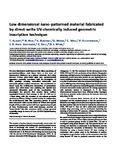Low-dimensional nano-patterned surface fabricated by direct-write UV-chemically induced geometric inscription technique
| dc.contributor.author | Allsop, T | |
| dc.contributor.author | Neal, R | |
| dc.contributor.author | Kundrat, V | |
| dc.contributor.author | Wang, C | |
| dc.contributor.author | Mou, C | |
| dc.contributor.author | Culverhouse, Phil | |
| dc.contributor.author | Ania-Castanon, JD | |
| dc.contributor.author | Kalli, K | |
| dc.contributor.author | Webb, DJ | |
| dc.date.accessioned | 2019-03-28T13:57:20Z | |
| dc.date.available | 2019-03-28T13:57:20Z | |
| dc.date.issued | 2019-01-15 | |
| dc.identifier.issn | 0146-9592 | |
| dc.identifier.issn | 1539-4794 | |
| dc.identifier.uri | http://hdl.handle.net/10026.1/13570 | |
| dc.description.abstract |
We investigate a nano-patterning process which creates reproducible periodic surface topological features that range in size from ∼100 μm to ∼20 μm . Specifically, we have fabricated multi-layered thin films consisting of germanium/silicon strata on a planar substrate, with each layer having nanometers thickness. The material processing exploits focused 244 nm ultra-violet laser light and an opto-mechanical setup typically applied to the inscription of fiber gratings, and is based upon the well-known material compaction interaction of ultra-violet light with germanium oxides. We show this process can be extended to create arrays of metal nano-antennas by adding a metal overlay to the thin film. This results in arrays with dimensions that span nanometer- to centimeter-length scales. Also, each nano-antenna consists of “nano-blocks.” Experimental data are presented that show the UV irradiance dosage used to create these metal nanostructures on D-shaped optical fibers has a direct relationship to their transmission spectral characteristics as plasmonic devices. | |
| dc.format.extent | 195-195 | |
| dc.format.medium | ||
| dc.language | en | |
| dc.language.iso | en | |
| dc.publisher | Optical Society of America | |
| dc.subject | Bioengineering | |
| dc.subject | Nanotechnology | |
| dc.title | Low-dimensional nano-patterned surface fabricated by direct-write UV-chemically induced geometric inscription technique | |
| dc.type | journal-article | |
| dc.type | Journal Article | |
| plymouth.author-url | https://www.webofscience.com/api/gateway?GWVersion=2&SrcApp=PARTNER_APP&SrcAuth=LinksAMR&KeyUT=WOS:000455620100004&DestLinkType=FullRecord&DestApp=ALL_WOS&UsrCustomerID=11bb513d99f797142bcfeffcc58ea008 | |
| plymouth.issue | 2 | |
| plymouth.volume | 44 | |
| plymouth.publication-status | Published | |
| plymouth.journal | Optics Letters | |
| dc.identifier.doi | 10.1364/ol.44.000195 | |
| plymouth.organisational-group | /Plymouth | |
| plymouth.organisational-group | /Plymouth/Faculty of Science and Engineering | |
| plymouth.organisational-group | /Plymouth/Research Groups | |
| plymouth.organisational-group | /Plymouth/Research Groups/Marine Institute | |
| dc.publisher.place | United States | |
| dcterms.dateAccepted | 2018-11-30 | |
| dc.rights.embargodate | 2020-1-15 | |
| dc.identifier.eissn | 1539-4794 | |
| dc.rights.embargoperiod | Not known | |
| rioxxterms.funder | EPSRC | |
| rioxxterms.identifier.project | Grating and waveguide plasmonic sensors | |
| rioxxterms.versionofrecord | 10.1364/ol.44.000195 | |
| rioxxterms.licenseref.uri | http://www.rioxx.net/licenses/all-rights-reserved | |
| rioxxterms.licenseref.startdate | 2019-01-15 | |
| rioxxterms.type | Journal Article/Review | |
| plymouth.funder | Grating and waveguide plasmonic sensors::EPSRC |


